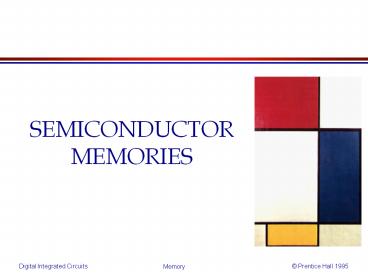SEMICONDUCTOR MEMORIES - PowerPoint PPT Presentation
SEMICONDUCTOR MEMORIES
Organized in regular and dense fashion (N)AND Decoder. NOR Decoder ... Semiconductor Memory Trends. Technology feature size for different SRAM generations ... – PowerPoint PPT presentation
Title: SEMICONDUCTOR MEMORIES
1
SEMICONDUCTOR MEMORIES
2
Chapter Overview
3
Semiconductor Memory Classification
4
Memory Architecture Decoders
5
Array-Structured Memory Architecture
6
Hierarchical Memory Architecture
7
MOS NOR ROM Layout
8
MOS NOR ROM Layout
9
MOS NAND ROM
10
MOS NAND ROM Layout
11
Precharged MOS NOR ROM
12
Characteristics of State-of-the-art NVM
13
Read-Write Memories (RAM)
14
6-transistor CMOS SRAM Cell
15
CMOS SRAM Analysis (Write)
16
CMOS SRAM Analysis (Read)
17
6T-SRAM Layout
VDD
M4
M2
Q
Q
M1
M3
GND
WL
M5
M6
BL
BL
18
Resistance-load SRAM Cell
19
3-Transistor DRAM Cell
20
3T-DRAM Layout
BL2
BL1
GND
RWL
M3
M2
WWL
M1
21
1-Transistor DRAM Cell
22
DRAM Cell Observations
23
1-T DRAM Cell
24
Periphery
25
Row Decoders
Collection of 2M complex logic gates Organized in
regular and dense fashion
(N)AND Decoder
NOR Decoder
26
Dynamic Decoders
27
A NAND decoder using 2-input pre-decoders
28
4 input pass-transistor based column decoder
29
4-to-1 tree based column decoder
30
Sense Amplifiers
31
Differential Sensing - SRAM
32
Latch-Based Sense Amplifier
33
Open bitline architecture
34
DRAM Read Process with Dummy Cell
35
Programmable Logic Array
36
Pseudo-Static PLA
37
Dynamic PLA
38
Clock Signal Generation for self-timed dynamic
PLA
39
PLA Layout
40
PLA versus ROM
41
Semiconductor Memory Trends
Memory Size as a function of time x 4 every
three years
42
Semiconductor Memory Trends
Increasing die size factor 1.5 per
generation Combined with reducing cell size
factor 2.6 per generation
43
Semiconductor Memory Trends
Technology feature size for different SRAM
generations
PowerShow.com is a leading presentation sharing website. It has millions of presentations already uploaded and available with 1,000s more being uploaded by its users every day. Whatever your area of interest, here you’ll be able to find and view presentations you’ll love and possibly download. And, best of all, it is completely free and easy to use.
You might even have a presentation you’d like to share with others. If so, just upload it to PowerShow.com. We’ll convert it to an HTML5 slideshow that includes all the media types you’ve already added: audio, video, music, pictures, animations and transition effects. Then you can share it with your target audience as well as PowerShow.com’s millions of monthly visitors. And, again, it’s all free.
About the Developers
PowerShow.com is brought to you by CrystalGraphics, the award-winning developer and market-leading publisher of rich-media enhancement products for presentations. Our product offerings include millions of PowerPoint templates, diagrams, animated 3D characters and more.































